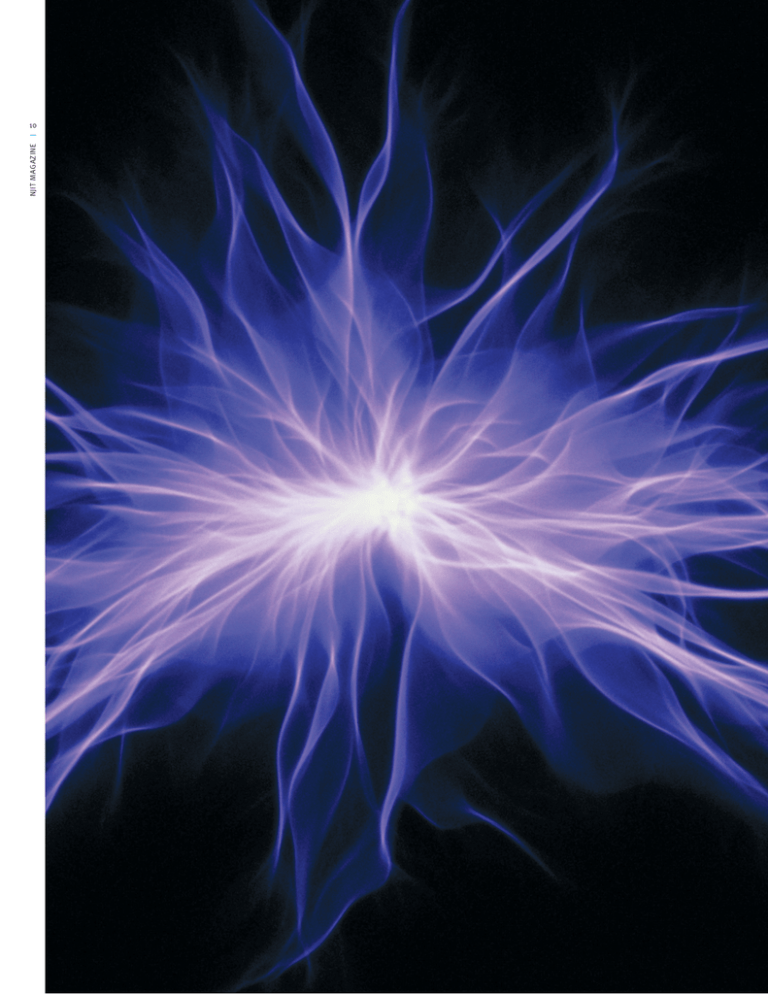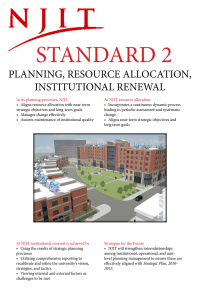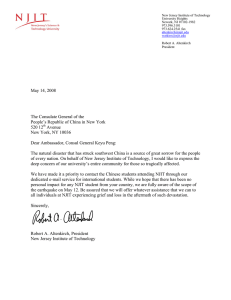10 NJIT MAGAZINE
advertisement

NJIT MAGAZINE 10 11 RESEARCHERS FROM INDUSTRY AND NJIT ARE MAKING THE NATION’S ELECTRIC POWER GRID SMARTER ONCE A WEEK, HARRY ROMAN, WHO GRADUATED FROM NEWARK College of Engineering in 1970, visits his old school. Wherever he wanders on the NJIT campus — academic departments, administrative offices, the cafeteria — people call out to him. “Harry, how are you?” asks a professor. “Hey Harry, good to see you,” says an administrator. “Do you have a minute, Harry?” asks a graduate student. Roman brightens considerably in the wake of the warm salutations. “It’s virtually impossible for me,” Roman says, “to walk into a department at NJIT and not know someone. It’s very gratifying. I have a network of friends here.” It’s a network of friends that is for Roman not just social but also professional. And his tie to NJIT could result in a technological breakthrough, one intended to “smarten” the nation’s electric utility grid. Roman, in a phrase, wants to create a “smart grid.” And in Ken Chin, a physics professor at NJIT, Roman has found just the right man to help him design such a grid. “Alumni need to know how valuable it is to partner with academia,” says Roman, a senior technology consultant for Newark-based energy company PSE&G. “As an engineer, I come at problems by using the rule of thumb and a body of practical knowledge. Professor Chin is a physicist who approaches problems first with the basic equations — then weaves his way back into the real-world problems we confront in the lab. Our collaboration is a perfect match of industry and academia.” The real-life problem that Roman and Chin confront in their NJIT lab is this: With hundreds of high-voltage electrical transformers moving thousands of megawatts of power, the failure of a transformer means big problems for PSE&G. If engineers could monitor the transformers with a network of sensors designed to detect small electrical sparks before they shut down a transformer, they could upgrade the grid. The sensor functions like an optical microphone, monitoring and AUTHOR: ROBERT FLORIDA is assistant director of public relations for NJIT. NJIT MAGAZINE PLUGGED IN AT NJIT NJIT MAGAZINE 12 measuring the noise and vibrations of sparks — a sure sign of potential problems inside a transformer. The sensors, for which PSE&G and NJIT have filed a patent application, could also monitor other utility equipment such as circuit breakers, voltage regulators and transformer tap changers. Worldwide, says Roman, there are perhaps hundreds of thousands of large transformers that could use these sensors — transformers that cost utility companies hundreds of billions. Roman and Chin are considering filing more patents to cover these potential uses of the sensors. But there’s a problem: Most electrical sensors are deadened by the strong magnetic fields that swirl inside of transformers. Each high-voltage trans- former, which costs between $1 million and $3 million to build, supplies electricity to 50,000 customers. Roman and Chin, though, think they have a solution. “We’re designing fiber-optic sensors because they are immune to electromagnetic radiation,” Roman explains. “We use light to measure the vibration that the sound of a spark makes on a diaphragm. The sensor is like an electronic ear that we’re training to recognize the acoustic signature of a spark.” Only one-third the thickness of a human hair, the sensor is mounted on a 7-inch probe to be installed in the transformers, which measure about 15 feet across and 12 feet high. However, this technology is not expected to be operational throughout the grid for a few years, Roman says. Ken Chin (left) and Harry Roman `70, `74 in the lab with a small utility transformer used to test the sensor technology that could give a significant boost to the reliability and security of the nation’s electric power supply. Less than the thickness of a human hair, the fiber-optic sensors being developed at NJIT are designed to monitor the operation of transformers as large as the one shown on the right. PHOTOS: BILL WITTKOP AND COURTESY OF PSEG 13 live long and healthfully. Whereas another person can be healthy, have no cardiac symptoms and one day just drop dead. Transformers are the same. Some of them have partial discharge, or sparks, but can last for years. Others have no damage but suddenly will have big problems and fail.” We use light to measure the vibration that the sound of a spark makes on a diaphragm. The sensor is like an electronic ear that we’re training to recognize the acoustic signature of a spark. The key to improving the electrical grid, says Chin, is to develop a way to monitor the grid and detect problems early. And that’s precisely what his and Roman’s sensors aim to do. Chin is quick to note, proudly, that his students have successfully demonstrated the sensor, which is a working device with great promise. PSE&G hopes to install the first sensors, as a test, in an older transformer sometime next year. “We expect breakthrough results,” Chin says. “It’s a great project and it’s great to work with an alumnus like Harry.” So Roman’s close ties to NJIT may, in the end, benefit PSE&G, as well as its millions of customers. For if PSE&G saves millions of dollars in repair costs and lost business due to blackouts, it could pass on those savings to customers. Roman would love to see that happen. “That’s my job,” Roman says. “To have electricity cheaply and reliably delivered to my customers.” Asked why he has remained so connected, for so long, to his alma mater, Roman smiles. “The older I get,” he says, “the more I realize how thorough my NJIT education was. But that’s not all. I love coming back because the students and the teachers still teach me things. I’m still learning. NJIT is for me an emotional link to the past. It gives me a sense of lineage. When I visit the campus, I see two universities: the one, in my memory, that I attended as a student in the late 1960s, and the one that exists now. And whenever I’m at NJIT, someone will turn to me and say, ‘Hey Harry! How ya doing?’” ■ NJIT MAGAZINE Roman has always loved inventing and helping other aspiring inventors. He holds nine patents for inventions as diverse as an automated meter reader, mobile robots and a process for speeding up production of the cancer drug Taxol®. He is also the chairman of the New Jersey Inventor’s Hall of Fame, founded in 1987 and sponsored by NJIT. In addition to his bachelor’s in electrical engineering, he holds a master’s degree in environmental engineering from NCE, completed in 1974. He works in Newark, lives in nearby East Orange, and ever since graduating has kept close ties to NJIT, serving on advisory boards, working with alumni and teaching graduate courses. The smart grid project is not the first time he’s worked with NJIT. In the early 1990s, Roman, along with a team of NJIT professors, built a robotics work station for PSE&G, one the utility used to inspect and test household electric meters. PSE&G employed the work station successfully for 10 years, Roman says. It was a device for which Roman, in conjunction with NJIT, received a joint patent. Chin, director of applied physics at NJIT, thinks that collaborating with an alumnus like Roman is a great benefit to NJIT. “Harry has more of an industrial engineering perspective,” Chin says, “while we are more science oriented. The knowledge Harry has, we lack; what we know, he lacks. We complement each other well.” Roman oversees and sets guidelines for the project, but Chin, along with two NJIT post-doctoral students and a doctoral candidate, perform most of the research. The project also benefits the students, who learn what it is like to work with industry, Chin says. Other companies are developing sensors for transformers, he adds, but their approach is limited. Some sensors being developed by industry are attached outside of the transformers. Chin and Roman install their sensors inside the transformer; that makes all the difference. “If you stand outside a concert hall, how much of the music can you hear?” Chin asks, by way of analogy. “If you are in the hall, you hear everything, right? Our sensors, inside the transformers, are 30 times more sensitive than the other sensors.” The utility grid is like a person, explains Chin. “One person can have a heart condition — high blood pressure, a heart muscle problem, etc. — for decades,” he says. “But if monitored closely, he can



